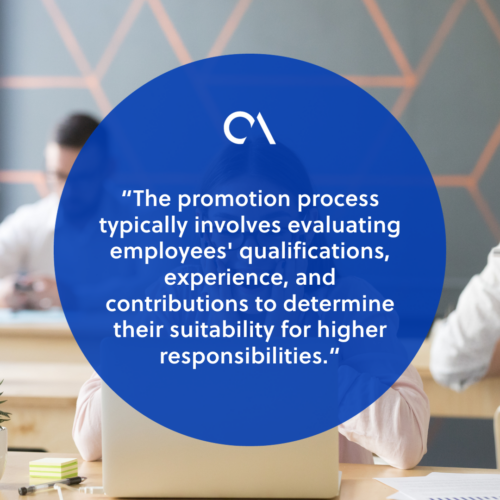Things to remember when considering employee promotion

Promoting employees is a significant decision that impacts individuals and plays a crucial role in shaping a company’s growth and success.
It not only recognizes one’s hard work but also fosters a positive work environment and encourages professional growth.
Forbes highlighted the importance of promoting staff, saying it helps recognize talent within and outside an organization.
This article explores essential aspects to consider when contemplating employee promotion. We discuss the promotion process, its types, benefits, considerations, and timing.
What is an employee promotion?
Employee promotion refers to the advancement of workers to higher-level positions within an organization.
It is a recognition of the staff member’s exceptional skills, performance, and potential for growth.
The promotion process typically involves evaluating employees’ qualifications, experience, and contributions to determine their suitability for higher responsibilities.
Employee promotions come in many forms, but they usually involve a mixture of:
- Increased compensation
- Higher job title
- Expanded and elevated responsibilities
- More authority in decision-making
- New leadership duties

Types of employee promotion
When considering employee promotion, there are various types to consider:
Vertical promotion
A vertical promotion moves an employee to a higher position within the same or different department.
It involves a clear and upward progression in the organizational hierarchy and comes with increased responsibility, salary, and job title.
Horizontal promotion
A horizontal promotion, aka lateral promotion, moves someone to a position with similar responsibilities or levels. However, it offers broader experience or opportunities in a different department or location.
Horizontal promotions help organizations leverage employees’ skills and experience in new settings.
Dry promotion
A dry promotion is an advancement in job title or salary alone, without any increase in job responsibilities or duties.
It may arise due to changes in organizational structure or job grading. Although, it does not translate into new learning opportunities and career growth for the staff member.
Open and closed promotions
An open promotion is available to all eligible employees throughout the organization.
It provides a level playing field for all qualified employees to apply. The selection process is based on merit and suitability for the role.
In contrast, a closed promotion fills a specific role with an internal candidate chosen by management.
It may be less transparent and open to a smaller pool of workers, but it can provide continuity, stability, and recognition of internal talent.
Benefits of employment promotion
Employee promotion offers numerous benefits for both the organization and the individual:
- Boosts morale and motivation. Recognition and advancement motivate employees to excel and contribute positively to the company’s success.
- Talent retention. Promotions can help keep top talent within the organization, reducing turnover and associated recruitment costs.
- Enhanced productivity. Workers who see a clear path to advancement are likelier to be engaged and productive in their roles.
- Skills development. Promotions often require employees to acquire new skills and take on increased responsibilities, fostering personal and professional growth.
- Succession planning. Employee promotion helps identify and prepare future leaders within the organization, ensuring continuity in leadership positions.

What to consider for employment promotion
Here are several key factors to keep in mind when considering employee promotion:
Performance and achievements
Evaluate an employee’s performance, achievement of goals, and consistent demonstration of skills, knowledge, and dedication in their current role.
Look for tangible examples of their impact on projects, ability to exceed expectations, and contributions to the team and organization.
Skillset and potential
Consider the team member’s skills, knowledge, and potential for growth.
Assess if they possess the necessary competencies and if their current skillset aligns with the requirements of the higher-level position or new responsibilities.
Fit with company culture
Evaluate how well the worker embodies the company’s values, mission, and culture.
Consider if they show leadership qualities and if they can contribute positively to the team and the work environment.
Career path and aspirations
Discuss the employee’s career aspirations and goals to see if the promotion aligns with their long-term development plan.
Check if they are genuinely interested in taking on the new role and its responsibilities.
Impact on a team
When promoting an employee, think about how it will affect the team. Consider if the promotion will improve teamwork or cause disruption.
Ensure there’s a capable replacement to maintain work continuity. Communicate openly with the team about the promotion’s reasons and potential impact on their tasks and morale.
Equity and fairness
Promotions should be based on clear and consistent criteria, ensuring equal opportunities for all. Avoid bias and favoritism and encourage diversity and inclusion in promotion decisions.
Have a system for staff to appeal if they believe a promotion was unfair. This develops transparency and fairness in your organization.

When to promote an employee
Timing is critical when considering employee promotion. While there is no one-size-fits-all answer, here are some indicators that it may be the right time:
- Consistent performance. Employees who consistently deliver exceptional results and exhibit a strong work ethic may be ready for a promotion.
- Demonstrated leadership. Workers who take on leadership roles, mentor others, or proactively seek extra responsibilities show potential for advancement.
- Business growth. When the company experiences growth or expansion, it often creates opportunities for promotions to fill new or expanded roles.
- Succession planning. Promotions can be part of a strategic succession plan to ensure a smooth transition when a key role becomes vacant.
- Employee aspirations. When an employee expresses a desire for growth and development, it’s worth considering their suitability for promotion.
By considering these factors and following a systematic approach to employee promotion, organizations can make informed decisions that benefit everyone involved.
Promoting employees rewards their hard work and dedication, contributes to a positive work culture, increases employee engagement, and develops a strong talent pipeline.







 Independent
Independent




